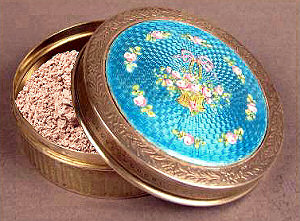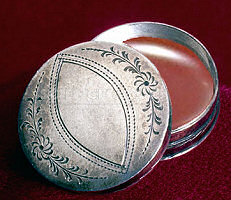|
Pictures:
1. Ackermann's Repository 1817
2. French Guilloche enamel ladies powder box from around 1838. 2 3/4 inch wide.
Notes on the text:
a-e:: For further information on the face lotions, she the special Complexion page
f: Unless otherwise stated all quotes are from 'Mirror of the Graces', first published 1811. Reprinted in facsimile edition 1997 as Regency Etiquette, not a very good title as it's a woman's beauty book. A review of the book can be found here.
g: Johann Bartholomäus Trommdorff. Kallopistria, oder die Kunst der Toilette für die elegante Welt. Erfurt 1805.
h: The druggist's general recipe book by Henry Beasley, published 1850
i: "Companions for the toilette - Almond Bloom, or Vegetable Rouge
A Pears, Prefumer, No. 55, Well's-street, Oxfrd-street, with all due respect to the Female World, embraces this opportunity of recommending his Almond Bloom, or Liquid Vegetable Rouge, to distinguished attentioon.
This invaluable Preparation, although it may be said to be in its infancy , from the short time that has occurred since it was first introduced to public notice, has required a reputation almost unparalleled in the annals of personal improvement. Its principal excellencies are the softening the skin for a free perspiration, adhering firmly to the face, giving a light and delicate tint that cannot be distinguished from nature. Five shillings per bottle. - Advertisement, La Belle Ansemblée, October 1807.
j: Chemistry for Beginners By Lincoln Phelps, 1850
k: Pear's White Imperial Powder is an admirable Companion to the above, being the most simple and effective Cosmetic in fashionable use. It is produced from Vegetables only, and gives to the Skin a delicacy strictly consonant to true Beauty, nor can the most circumspective observer preceive the application of it on the Countenance. Price 2s. 6d. and 5s. per Bos. - Advertisement, La Belle Ansemblée, October 1807.
l: Pear's Liquid Blooms of Roses gives a most delightful tinge to the Female Countenance, and to such a degree of perfection, that it may with propriety be said that Art was never so successfully employed in improving the Charms of Nature. Price 5s. 6d. per Bottle. - Advertisement, La Belle Ansemblée, October 1807.
m: A supplement to the Pharmacopoeia: being a Treatise on Pharmacology in General by Samuel Frederick Gray, 1821
n: The London Magazine, 1826
n1:Elements of Practical Agriculture, comprehending the cultivation of plants, the husbandry of the domestic animals and the economy of the farm by David Low, published 1838
o: The druggist's general recipe book by Henry Beasley, published 1850
o1:Ackermann's Repository of Arts, p 88-91, No 2, Vol 1 1809
p: The Edinburgh New Philosophical Journal, 1834
q: The London Magazine, 1826
r: The druggist's general recipe book by Henry Beasley, published 1850
s: "To Ladies who have occasion for Rouge, Rigge begs to recommend this Liquid Bloom, made from Damask Roses. This Rouge is so suitable to the complexion that it cannot when judiciously applied be distinguished from a natural Bloom. It is as innocent as simple Rose Water, and may be used to the lips, when required, with pleasing effect, price 3s. 6d. and 7 s. Those elegant and approved articles are prepared at D. Rigge's Plantation, Wandsworth, and sold in London, at his Warehouse only, No. 31, New Bond-street." -Advertisement in La Belle Ansemblée, January, 1808.
t: The Essence of Pearl and Pearl Dentifrice, invented by the late Baron Hemet, dentist to the Royal Family, have been proven by long experience to greatly excel both in elegance and efficacy, every other preparandum for the teeth and gums: they effectually preserve the teeth in a sound state even to old age, render them white and beautiful without imparing the enamel, fasten such as are loose and keep such as are decayed from becoming worse. They likewise render the breath delicately sweet, prevent the tooth-ach, perfectly cure the scurvy in the gums, and make them grow firm and close to the teeth. The essence is particularly recommended to parents and persons who have the care of children as the greatest preservative of young and tender teeth. None are genuine but what have the words "J Hernet, Bayley and Brew, Cookspur street;" engraved on the stamp: price 2 s 8d each. Bayley's true Essential Salt of Lemons to take ink spots and stains out of lace and linen. The resine is signed #J Bayley" on the box and wrapper: also Brs Scoors Drops, for taking grease out of silk, stud, woollen cloth &c, price 1s each. Perfumed Pommade Davie, price s 8d, Liar glass. Sold wholesale and retail, oy Bayleys and Brew, perfumers, Cockspur street, London. - Advertisement in The Times, March 9 1819.
|





